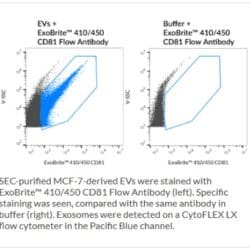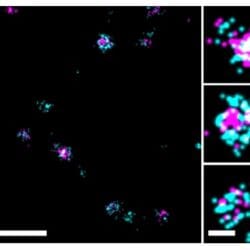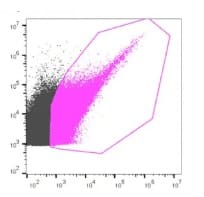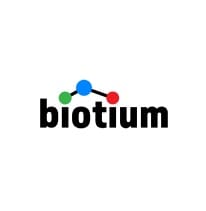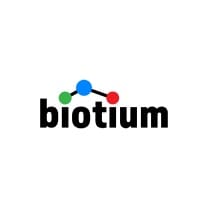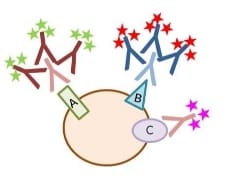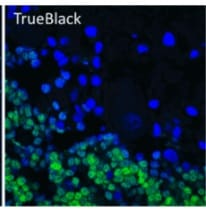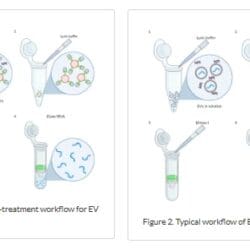Check out the latest news from Biotium USA, a leading provider of innovative fluorescent solutions for scientists.
Biotium is devoted to providing high-quality and innovative fluorescent tools that fuel scientific discovery.
Since its founding in 2001, Biotium has developed over 30 patented technologies including GelRed® dyes, CF® Dyes, NucView® Caspase-3 Substrates, EvaGreen® Dyes, and TrueBlack® Background Reducers.
-
BIOTIUM | ExoBrite™ Flow Antibody Conjugates
Validated Antibodies for Detection of EV Markers by Flow Cytometry The most common proteins used as EV markers are CD9, CD63, and CD81, members of the tetraspanin family. While antibodies targeting these proteins are available by commercial suppliers, few are validated or perform well for detection of EVs or exosomes. The antibodies and dye labels […]
Read More -
BIOTIUM | SUPER-RESOLUTION IMAGING
High-Performance EV Stains for Super-Resolution Featuring STORM-Optimized CF® Dyes Characterizing exosomes and EVs by imaging is challenging due to their small size and the resolution limits of conventional light microscopy. Super-resolution techniques like direct stochastic optical reconstruction microscopy (dSTORM) overcome these limits, providing single-molecule resolution of subcellular structures such as EVs. This enables deeper insights […]
Read More -
BIOTIUM | ExoBrite™ Antibody Cocktails
Streamline Your Workflows with High-Coverage EV Staining or Robust Phenotype Analysis Biotium’s ExoBrite™ CD9/CD63/CD81 Antibody Cocktails are antibody mixtures developed with optimal brightness and signal-to-noise for detecting EVs. The single-colour cocktails were developed for high-coverage EV antibody staining by flow cytometry. For phenotyping analysis, the 3-colour cocktails provide distinct fluorescent labels for each marker, enabling […]
Read More -
BIOTIUM | Biotium’s ExoBrite™ Flow Antibody helps validate an upscaling protocol for potential exosome-based therapies
Exosome-based therapies are gaining attention in regenerative medicine for their ability to modulate cellular behaviour and enhance tissue repair. Exosomes derived from mesenchymal stem cells (MSCs) have been shown to carry bioactive molecules such as proteins, lipids, and nucleic acids that facilitate intercellular communication and tissue regeneration. While MSC-derived exosomes have demonstrated therapeutic potential for […]
Read More -
BIOTIUM | Protocol: Cell Surface Antibody Staining for Flow Cytometry
There are many protocols for staining cells for flow cytometry. Protocols may to need be optimized for different cell types, targets, or applications. This is our basic protocol for extracellular staining of cell surface epitopes in suspension cells for flow cytometry.
Read More -
BIOTIUM | Protocol: Immunofluorescence Staining of Cells for Microscopy
There are many variations on IF protocols, and steps may need to be optimized for different targets or applications. Some epitopes may require specific fixation conditions for detection. This is our basic protocol for staining adherent cells in dishes or cells grown on coverslips.
Read More -
BIOTIUM | Tech Tip: Combined Direct and Indirect IF Using Primary Antibodies from the Same Host
Phalloidin Conjugates ORDER HERE Mix-n-Stain™ CF® Dye Antibody Labelling Kits ORDER HERE
Read More -
BIOTIUM | Tech Tip: Battling Tissue Autofluorescence
TrueBlack® Lipofuscin Autofluorescence Quencher, 20X in DMF ORDER HERE TrueBlack® Plus Lipofuscin Autofluorescence Quencher, 40X in DMSO ORDER HERE
Read More -
Biotium | DNase pre-treatment of the EV exterior improves EV RNA yield
Extracellular vesicles (EVs) are known to contain RNA, including microRNA (miRNA) and mRNA, derived from the cell of origin. Studying EV RNA can be useful for many purposes: determining the cellular source of the EVs, for disease diagnostics (Ref. 1), and for identifying oncogenic RNAs (Ref. 2). Since EVs are very small (~30-200 nm in […]
Read More -
Biotium | ExoBrite™ CTB EV Stain assists in evaluating engineered EVs for targeted drug delivery against triple-negative breast cancer
Triple-negative breast cancer (TNBC) is an aggressive cancer type with no specific therapeutic targets, leaving chemotherapy as the primary treatment option. However, chemotherapy is often highly toxic for patients with limited effectiveness, underscoring the need for new therapeutic strategies. Researchers are examining the potential of extracellular vesicles (EVs)- small, cell-derived particles that are naturally highly […]
Read More

